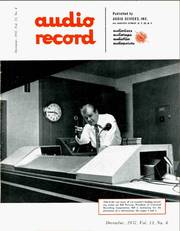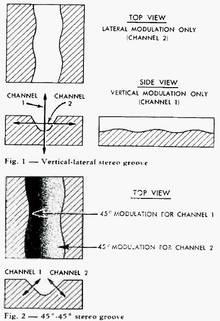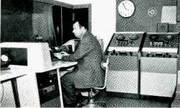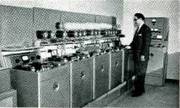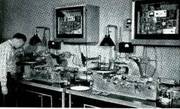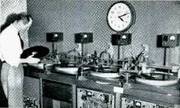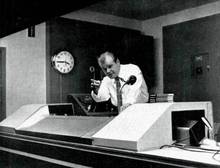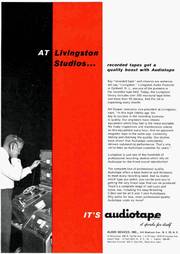Die Zeitschrift "audio-record" - Was ist (war) das Besondere ?
Diese Firmen-Zeitschrift war Jahrzehnte verschollen. Doch da stand eine Menge über den nationalen amerikanischen unabänderlichen Weg zum ungeliebten (und teilweise diffamierten) deutschen Magnetophon-Tonband drinnen. Mit diesen Informationen kann jetzt eine Menge an Schallplatten-Historie und ganz früher Magnetband-Historie "gerade gerückt" werden.
Das Jahr 1957 war wieder einmal ein besonderes Hifi-Jahr ...
In den USA wurde die 33er Stereo-Schallplatte als Erweiterung der fast 10 Jahre alten 33er Mono-LP vorgestellt. Bislang gab es für Musik-Fans und Stereo-Freunde nur die fertig bespielten Musik-Magnetbänder in Halbspurtechnik und mit 19cm/s, also etwa 45 Minuten gute Stereo-Musik für recht teures Geld. Mit der Stereo-Bandgerätetechnik war das für die Masse der Musikfans zu teuer. - In der Dezember-Ausgabe der Audio Record finden wir 2 ganz ganz frühe Artikel, die bemerkenswert sind. Die anderen Hifi-Magazine und Audio-Zeitschriften publizierten erst ab Mitte 1958, daß sich da im LP-Plattenbereich etwas Neues tat.
.
Der Vizepräsident der Firma "Audio Devices" schreibt unter :
"audio pointers - for the Recordist" - (December, 1957 No.4)
by C. J. LeBel Vice President, Audio Devices, Inc.
STEREO DISCS
The last few months have seen intense interest in stereo reproduction, with enormous growth in stereo tape sales and use, and widespread excitement about stereo discs. We seldom use such extravagant terms, but nothing weaker would fit the stereo session at the recent "Audio Engineering Society" Convention, with about 500 present. Interest is certainly boiling.
We detect in the general public's thinking the assumptions that stereo discs are new, and that the stereo disc and its reproduction equipment will necessarily be lower in cost than are stereo tape and equipment. These assumptions are not entirely sound.
Stereo disc is a very old idea; a vertical-lateral system was patented by Bell Telephone Laboratories about 1937. The patent also described the latest disc, in which one channel is carried by a motion 45° to the left of vertical, and the other 45° to the right or vertical. This produces a balanced system, in which the transmission characteristics of the two channels are alike; in the vertical-lateral system the distortion characteristics are unlike.
The following discussion will suggest that both tape and disc stereo have problems, and that while the problems are sometimes unlike, they promise to be equally troublesome.
.
Tape
Tape admittedly has been higher in cost than some would enjoy, but not enough to prevent an estimated twentyfold increase in stereo sales in the last year. This cost has been raised by the relatively small quantities involved in a pioneering effort; larger production should yield lower cost.
Equipment has been higher in cost than one would like, but the head output voltage is low and therefore demands good amplification. And, of course, two channels cost twice as much as one.
Overall interchannel leakage seems surprisingly high by motion picture standards - only about 35db below signal - but this seems to be inaudible in home stereo.
On the other hand, tape is free from ticks and pops; tape hiss is not as objectionable in stereo as are disc ticks and pops.
Disc
The cost of a stereo disc has been forecast as being no higher than that of a monaural disc; this is only partly true. Apart from amortizing the necessary capital investment, better quality control of processing will be needed. Ticks and pops do not have a stereo character.
When they are heard as distinctly "left handed" or "right handed," they can be very disconcerting. Discs which are virtually free from ticks and pops can be made - have often been made - but complete consistency of quality inevitably raises cost. Incidentally, how many of us care for our discs so well that storage and use do not produce a tenfold increase in ticks and pops ?
Next comes the question of component quality and cost. A stereo pickup will consist of two separate pickup structures plus a suitable linkage to attach the stylus. Each pickup will act as a load on the other, and the linkage forms an overall compliance-load. If we are to retain the stylus loading and frequency range which the high fidelity field demands, extraordinarily light structures and linkage will be required much higher level engineering than is presently required for a given quality rank. The low fidelity mass production field will not be worried about such problems.
To retain a given pickup quality level with near the ordinary grade of engineering, it will be necessary to sacrifice output voltage - which suggests that more preamplification will be needed, and thence better amplifier engineering to keep hum down.
No attention has hitherto been paid to the vertical rumble of popular priced turntables - only lateral rumble was reproduced by a lateral pickup. It will be interesting to hear what happens when both types of rumble are reproduced on a low cost turntable.
The claim has been made that since the stereo disc can be played by an ordinary non-stereo pickup, all disc production will be stereo, and the monaural disc will become obsolete.
Probleme mit den Mono-pickups ...
This is wishful thinking, for the average lateral (mono-) pickup of today has relatively little vertical compliance - too little to permit it to yield adequately to the vertical component of a stereo groove.
On most existing monaural pickups, the stereo groove will be cut to bits in a very short time. We definitely believe that both stereo and monaural discs will be in the catalogs for quite a while.
Finally, overall interchannel leakage is about 35db below signal about the same as tape, and thus equally unobjectionable.
At the present time, leading American phonograph record manufacturers are testing handmade samples of the new Westrex type 3A dynamic (feedback) cutting heads.
By appropriate circuit arrangements, these can be arranged to cut either a vertical-lateral (fig. 1) or a 45°-45°(fig 2) stereo groove, and record manufacturers are cutting experimental discs of both types from their stereo tapes. After the engineers have agreed on the more desirable type, and a de facto standard exists, everyone will be able to get into production.
Stocks of discs should be available in about six months. Everyone is determined to avoid the confusion which would result from having two incompatible types of stereo discs - no one wants a situation like the "battle of the speeds" of some years ago.
Summary
The problems of stereo disc reproduction are rather formidable, and we foresee a rise in the ratio of price/quality in such systems. Low cost but low quality stereo disc equipment is probably not over six months away. There is a strong probability that high quality reproduction equipment for stereo disc will cost at least as much as for stereo tape, and possibly more.
Whether the formidable mechanical problems of high quality stereo disc reproduction equipment can be completely overcome at reasonable cost cannot be answered at the present moment. It seems to us that there will be peaceful coexistence, as there is now in the monaural field. The mass stereo market will probably be in disc, whereas the high fidelity field will probably prefer tape.
.
Weiter vorne ein Loblied auf die Firma "AUDIO DEVICE"
Diese kleine Zeitschrift war natürlich die hauseigene Werbeplatform und so wurden nur die Firmen vorgestellt, die mit Produkten von AUDIO DEVICE arbeiten. Und selbstverständlich stand da kein Wort vom Marktführer 3M (Scotch) oder dem Wettbewerber ORRadio (Irish) und deren Bändern. Von BASF und AGFA aus Old Germany war noch lange nichts zu sehen.
.
BEHIND THE SCENES AT UNIVERSAL RECORDING STUDIOS
By MARSHALL LEWIS in December, 1957
The Recording of Sound is the art of capturing selected Sound and holding it intact in a form, that can be merchandized ....... a phonograph record, tape, a sound track, a transcription.
.
Was macht die "Universal Recording Corporation" ?
The function of Universal Recording Corporation is, essentially, to package Sound.
.
That, briefly, is how the world's largest independent recording studio defines its business. Eleven years ago Universal Recording Corporation started in business with little more than an idea and some handmade equipment.
Today Universal has nine hundred active accounts, does the recording for such well known artists as Count Basie, Nat Cole, Wayne King, Duke Ellington, Burl Ives, Stan Kenton and Ralph Marterie; records commercials for leading advertising agencies; produces sound tracks for the industrial films of many of the country's largest corporations.
.
Bill Putnam, youthful founder and president of Universal
When we asked Bill Putnam, youthful founder and president of Universal, how his organization reached its present impressive position, he gave us this explanation:
.
"There are a lot of good technical men in this business. But a really top-notch mixer is a rare breed. He's got to be half-technician, half showman. Like a conductor, he has to be artistic enough to know what the performers are striving for ... and frequently he can add his own artistry to their performance. He must have complete control over the recording facilities ... that is, he has to understand their capabilities and limitations so well that he can actually package the sound he and the artist want to get."
Bill comes by his technical ability honestly. He majored in Communications Engineering at Valparaiso Technical Institute. For a number of years he worked as engineer and chief engineer at radio station WDAN in Danville, Illinois, and WDWS in Champaign.
During the war, Bill took the civil service examination and was appointed Assistant Corps Area Radio Engineer for the Sixth Service Command. He spent most of his time coordinating the development and manufacture of top-secret electronic devices for the armed forces.
.
Bill Putnam and "Universal"
In 1946 Bill founded Universal Recording Corporation .... handling small jobs with modest facilities. Everything in those days was done on discs ... there were no tape recorders.
A few months after Universal opened its shop, it was given a contract to transcribe all "American Broadcasting Company" programs, and during the life of this contract Universal recorded more than 20,000 programs. It was with these transcriptions that the practice of delayed broadcasts began.
.
As the business grew and kept pace with Universal's growing reputation, the company found it necessary to move to bigger and better quarters three times before they arrived at their present impressive airconditioned plant on the fashionable Near North Side of Chicago. Here Universal has three large studios, dubbing room, mastering room, editing and assembly room, stereophonic editing room, high-speed duplicating room, clients' listening room, and a number of offices.
Marktführer in Qualität
Probably as well as anyone in the business, Bill Putnam lives up to his own specifications of a good mixer. It is a fact that many of the country's best known recording artists insist that he be in charge of their recording sessions, and they will travel half way across the country to cut their records at Universal.
This is not hard to understand when you think of the hit records Bill Putnam has helped to produce: "Peg O' My Heart," "Mule Train," 'Jealous Heart," "Melody of Love," and many other million-copy sellers. And, among other things, Putnam was one of the pioneers in the use of the echo chamher in pop recordings.
Mason Coppinger, Vice President and Chief Engineer
The appeal that Bill Putnam has for artists and record companies has a counterpart in the respect held by advertising agencies and their clients for Mason Coppinger, Vice President and Chief Engineer of Universal. Before Mase joined forces with Universal less than a year ago, he was Chief Engineer for Columbia Records in Chicago, where he had built up a loyal following among the people responsible for advertising commercials. Like Bill Putnam, Coppinger is one of the "rare breed" ... a master technician with the instinct of a showman. He is also responsible for Universal's work in automatic and manual slide film sound tracks and the music library. (Universal has one of the largest music libraries in the midwest.)
Stereophonic Recordings - (wir sind immer noch in 1957)
Putnam and Coppinger are both enthusiastic about the future of stereophonic recordings. They have done considerable pioneering work in the field, and Universal is one of the few studios equipped to make stereo recordings at the same time as monaural.
By making use of a separate mixing location in the control room, they can make both types of recordings simultaneously ... without involving changes in the conventional studio set-up and without requiring additional time.
Coppinger points out the optimistic growth potential of this specialty. Sales of stereo tape recorders have leaped phenomenally within the last year. Universal is in a position to provide substantial economies for the producers of pre-recorded tapes.
Three Large Studios
Each of the three studios is an independent facility completely equipped with its own control room, Ampex No. 300 and No. 350 tape recorders, 10 and 14 mike position control consoles. There are program equalizer panels, separate echo chambers, filter effects and specially designed amplifiers for feeding cue to studio, for dubbing over backgrounds, and adding voice, etc. The echo chamber facility in each control room is designed so that separate echo can be added to any mike position at will ... in any degree desired by the mixer.
The largest of the three studios is approximately 4,000 square feet with a 25-foot ceiling. It is equipped with a unique arrangement for varying the acoustical properties of the room ... from an extremely dead sound stage to a "live" studio. This is ideal as a scoring stage or recording room for large orchestras or groups up to 100 pieces.
Control Room Console
The heart of the control room is a special console which has twelve mixing channels, eleven preamps and six amplifiers. Two completely isolated output program channels allow simultaneous stereo and monaural recording by feeding from left and right stereo bridging jacks ahead of the program amplifier and using a "combined" position to feed fixed monaural.
There is a provision for a split channel for recording background music and vocal separately and mixing them on playback. Two identical power supplies, designed for continuous duty cycle operating at 60% of load rating, are provided with instantaneous switchover in case of component failure. Ten plug-in equalizers provide for varying the response of each channel. Frequency response is ±1db from 20 to 20,000 cycles per second. Noise is equivalent to an input signal of 125 DBM or less. Output impedance is 150 ohms.
Dubbing Room
The dubbing room for reference discs and acetate copies contains a custom-made machine which produces four identical acetate or lacquer copies at one time.
All the recording heads and turntable speeds are synchronized, driven from one master motor unit. With this installation, it is possible to produce identical copies at a production rate far in excess of any equipment available commercially.
Mastering Facilities
All transcriptions are made on "Audiotape", all master discs on "Audiodiscs". There are two Scully lathes in the mastering room for cutting masters of standard 78 and 45 rpm phonograph records, radio transcriptions, LP and EP records.
Special program equalizers provide great flexibility in correcting deficiencies in various program tapes, making it possible to hold the highest quality on the finished master, whether record or transcription. Custom-designed and custom-built 60-watt recording amplifiers and feed-back recording heads contribute to quality control of the masters.
Editing and Assembly Room
The editing and assembly room is a completely self-contained independent facility with three Ampex tape machines and a three-speed turntable. There is provision for patching into any of three echo chambers. A program equalizer panel lets the engineer produce any variety of tonal equalization, and a five-position mixing panel permits him to produce "composite" tapes from any of the four program sources.
Duplicating Facilities
The duplicating department contains one "master" Ampex unit and six "slaves." (A seventh slave unit is on order.) Tape can be duplicated at either 30 or 60 inches per second. Mass production of prerecorded tapes for home use is done at the faster speed. The performance of each machine is checked with a trial run every morning and is serviced every week. One reel out of each run is tested for quality ... each time from a different machine.
Among the customers of the Duplicating Department are VM Corporation, (sample tapes for their recorders), Pentron Corporation (pre-recorded tapes) and Sears Roebuck for point-of-sale recordings. With its complete facilities, Universal is able to "package" a complete deal for its customers They can control the quality of a prerecorded tape from the actual recording, through the editing and preparation of the master reel, to the mass production of the commercial item.
Und am Ende weitere Lobhudelei .....
We asked Bill Putnam and Mase Coppinger why Universal used Audiotape and Audiodiscs exclusively. The answer tied in with the half-engineer, half-showman nature of the two men.
In the first place, they had complete confidence in Audio's consistent standard of quality. As Bill put it, "It's pretty embarrassing to run a whole recording and then find that your tape missed something ... that doesn't happen with Audiotape." Service ... the fact that Audio can give fast delivery on Universale emergency requirements ... is another important factor.
Bill Putnam is impressed with the original research Audio is responsible for in this highly technical field. He is keenly and personally interested in Audio's work in correcting "print-through" ... a problem which until now has been common to all tapes.
(Ed. Note: This research led to the development of Master Low Print-Through Audiotape which reduces print-through - magnetic echo by 8db.)
Says Bill: "I accept Audio's LeBel as one of the real technical authorities in the field ... when he has something to say, I listen."
Hier die eigene Werbe-Anzeige hinten auf der Rückseite:
At Livingston Studios ...
... recorded tapes get a quality boost with "audiotape".
Say "recorded tape" and chances are someone will say "Livingston." Livingston Audio Products in Caldwell, N.J., was one of the pioneers in the recorded tape field. Today, the Livingston library includes over 160 monaural tape titles and more than 90 stereos. And the list is expanding every month.
Art Cooper, executive vice-president at Livingston, says, "In this high fidelity age, the key to success in the recording business is quality. Our engineers have chosen equipment which they feel is the finest available. We make inspections and maintenance checks on this equipment every hour. And we approach magnetic tape in the same way - constantly testing and checking the quality. Our studies have shown that Audiotape consistently delivers outstanding performance. That's why we've been an Audiotape customer for years."
Livingston is just one of the hundreds of professional recording studios which rely on Audiotape for the finest sound reproduction.
The complete line of professional quality Audiotape offers a base material and thickness to meet every recording need. And no matter which type you select, you can be sure you're getting the very finest tape that can be produced.
There's a complete range of reel sizes and types, too, including the easy-threading C-Slot reel for all 5 and 7" Audiotapes. Why settle for less, when professional-quality Audiotape costs no more?
AUDIO DEVICES, INC., 444 Madison Ave., N.Y. 22, N.Y.
In Hollywood: 840 N. Fairfax Ave. • In Chicago: 5428 Milwaukee Ave. Export Dept: 13 East 40th St., N.Y., 16 • Cables "ARLAB" Rectifier Division: 620 E. Dyer Rd., Santa Ana, Calif.

